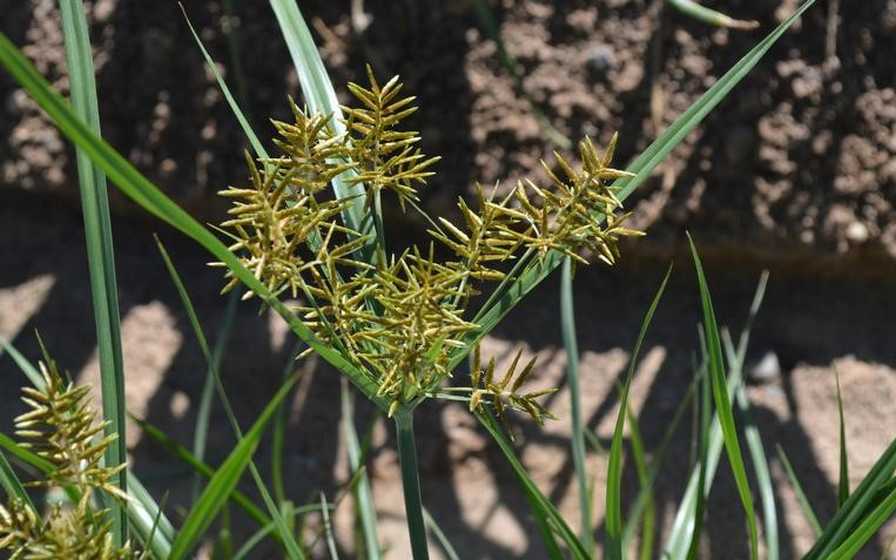What You Can Do To Protect Your Potato Crop from Yellow Nutsedge

The seed-head-like flowers of yellow nutsedge can be deceptive. Yellow nutsedge’s biggest threat is its tuber.
Photo by Howard F. Schwartz
Yellow nutsedge ranks among the worst weeds in the world because, once established, you will find it almost impossible to eradicate it.
Here’s what you need to know.
How to Recognize It
Yellow nutsedge, Cyperus esculentus var. esculentus, is a perennial weed with bright-green, narrow leaves that are pointed at the tips. It can look like a grass, but the stems are triangular and are stouter than the stems of most grasses.
It usually forms in dense patches and grows to 12- to 32-inches tall. The plants produce yellowish-brown flowers in narrow spikelets.
They form seeds, but seedlings are not common. Yellow nutsedge grows and spreads primarily from tubers and rhizomes that develop underground. Tuber production is prolific — one tuber can give rise to thousands more within a season. Cold winter temperatures usually kill the aboveground parts of the plant, rhizomes, and roots. But the tubers generally survive and germinate in the spring to form new plants.
This weed is adapted to tropical and temperate climates, grows faster in warm conditions, and prefers wet areas. Yellow nutsedge can be found throughout most of the U.S. but thrives in irrigated cropping systems. It tends to sprout later than many other spring-germinating weeds but can produce new leaves every four to five days if conditions are favorable.
Damage Threat
Yellow nutsedge, like other weeds, can reduce potato yields by competing for water, nutrients, light, and space.
It does not tolerate shade, however, so the weed’s growth is usually suppressed once potato rows close. Potatoes that are planted early, when cooler temperatures favor crop growth over the weed, are more likely to overtake yellow nutsedge. This does not entirely stop the weed from producing rhizomes and tubers, which can grow into or penetrate through potato tubers causing them to be graded as culls. In processing potatoes, nutsedge tubers may be considered “foreign material,” which could lead to crop rejection.

Unlike most weeds, yellow nutsedge can force growers to cull their crops. Yellow nutsedge can grow into potatoes (seen here) or its own tubers can mix into your harvest.
Photo by Jose Felix
How to Prevent a Take-over
Prevention is the best strategy for managing yellow nutsedge.
Consult personnel from noxious weed programs to know if and where yellow nutsedge has been found in your area. Learn how to identify it. Scout for plants and remove them when you find them.
Avoid infesting clean fields with nutsedge tubers and rhizomes, which can adhere to soil clumps. Clean equipment before moving from infested fields. Do not use potato seed tubers (or transplants for vegetatively propagated rotation crops) from fields infested with yellow nutsedge.
If there are isolated patches of yellow nutsedge in the field, maneuver tillage equipment around the area to avoid further spread.
Cultural Management Tips
Tillage resulting in deep burial of tubers may delay emergence of the weed but is not likely to control it. Fall tillage that brings nutsedge tubers to the surface and exposes them to cold temperatures can reduce populations.
Hand-weeding can be effective if you remove the entire plant. But this strategy can be too costly if you face a large infested area.
Cultivation can disturb nutsedge plants that are developing between rows, but regrowth from tubers is common. Cultivating every two to three weeks for several weeks can deplete tuber reserves so they eventually stop resprouting, but this is not usually practical in potatoes.
Promote potato growth to achieve early row closure. Early planting when temperatures are cooler can give potatoes a competitive advantage over yellow nutsedge. Choose vigorous potato cultivars. Avoid planter skips.
Include fast-growing crops with dense canopies in your rotation (corn, wheat, and forages) that will shade yellow nutsedge and suppress its growth. Avoid slow-growing crops with open canopies (onions) that allow extensive growth and spread of yellow nutsedge.
Chemical Management
Soil fumigation with metam sodium (Vapam, Sectagon) can kill nutsedge tubers, but control is variable and depends on the depth of application, dose, and the tuber’s develop-mental stage.
Glyphosate (Roundup) can burndown the aboveground growth of yellow nutsedge, but it usually does not translocate to the rhizomes and tubers. So new sprouts can emerge later. Re-treatment can help by eventually depleting the reserves in tubers. This strategy only works when nutsedge emerges before the crop. Glyphosate is often used for spot treatment or treatment of fallow ground.
Rotation crops may offer more options for controlling yellow nutsedge with herbicides. For instance, halosulfuron (Sandea, Permit) can be very effective for postemergence control in crops like alfalfa, beans, corn, and some cucurbits.
In parts of Africa, Asia, and Europe, yellow nutsedge is grown for its tubers (also called tiger nuts, chufa nuts, or earth almonds). The cultivated variety of yellow nutsedge, Cyperus esculentus var. sativus, is less aggressive than the weed and produces larger tubers. The tubers have a nutty flavor and can be eaten raw, roasted, ground into flour, or made into a beverage. If you lose your battle with yellow nutsedge, then perhaps you can grow it as a crop and hope more people develop a taste for tiger nuts.
Most Used Herbicides
The following herbicides are the most commonly used chemistries to control nutsedge. However, read the product labels carefully because many of these herbicides have strict use restrictions and detailed instructions that vary depending on soil types, tank mix partners, and more.
| Herbicide | Supplier | Timing |
| EPTC (Eptam) | Gowan Co. | Applied preplant incorporated |
| Dimethenamid-P (Outlook) | BASF | Applied preemergence |
| S-metolachlor (Dual Magnum) | Syngenta | Applied preemergence and/or postemergence |
| Rimsulfuron (Matrix) | Corteva | Applied preemergence and/or postemergence |
| Metribuzin (Boundary) | Syngenta | Applied preemergence and/or postemergence |










